When I started at Buffer, I was given permission to make mistakes, to ask forgiveness rather than permission, to always test everything.
So I’d like to give you all some permission as well.
You have permission to pick and choose your social networks.
In fact, often times it may be best not to be on certain social networks, perhaps because of the time it takes to do social right or because your customer personas don’t fit with a particular network. When you’re choosing which social networks to be involved with, it’s okay to be picky. You have my permission.
The next step is making an educated decision on which social networks to choose. There are a big number of factors that could weigh a decision for you, and I’ve done my best to collect them here in this post. From demographics to research and a whole lot else in between, here is what I’ve found to help you choose your social networks.
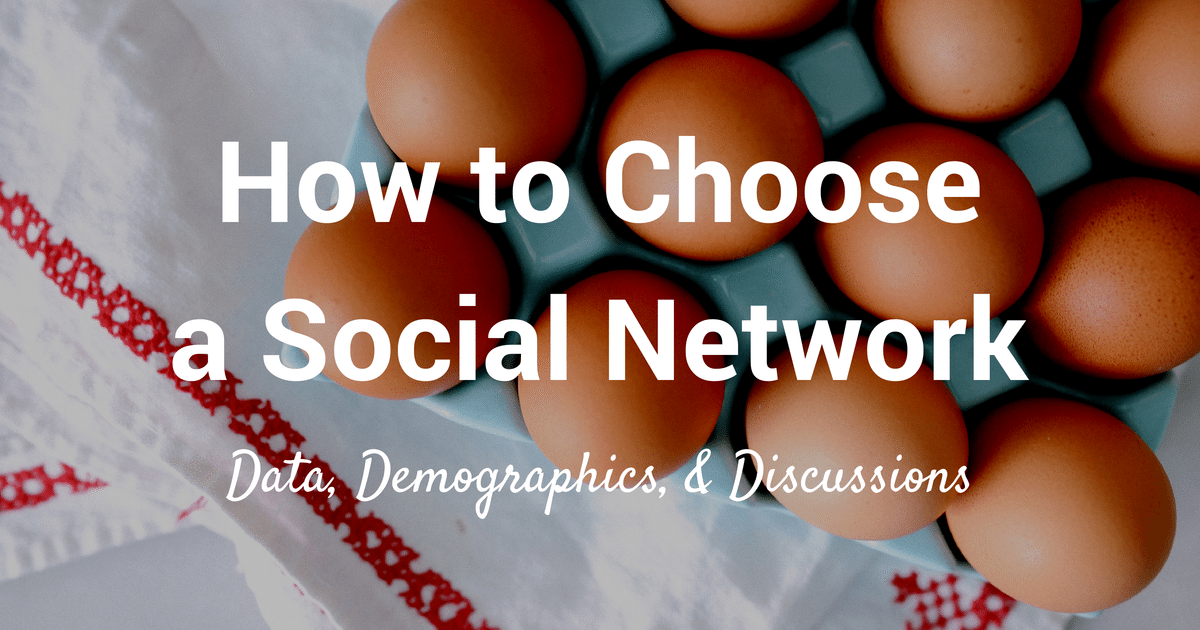
The most popular social networks, by active users
What the raw data can tell you about choosing a social network
According to data pulled together by Digital Insights, here’s the breakdown for the social networks with the most monthly active users. You can check the Digital Insights blog for the overall number of users, too, although active users is likely to be a more meaningful metric when making decisions.
Social networks, ranked by monthly active users:
- Facebook: 1.28 billion
- Google+: 540 million
- Twitter: 255 million
- Instagram: 200 million
- LinkedIn: 187 million
- Pinterest: 40 million
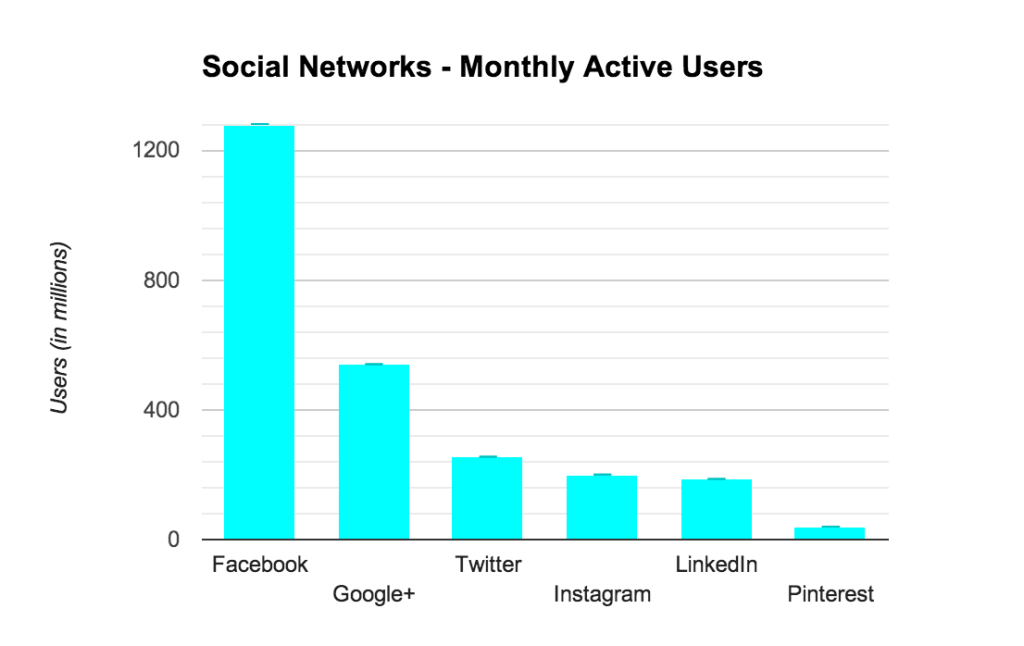
You’ll notice that Facebook is far and away the most popular social network, with twice as many monthly active users as the runner-up. You’ll notice a Facebook-as-king theme running through much of these stats.
Here is the chart for social network growth, courtesy of a report published at the first of the year by GlobalWebIndex. It acts as a nice counterbalance to the overall active user numbers since it highlights what may be some up-and-coming social networks.
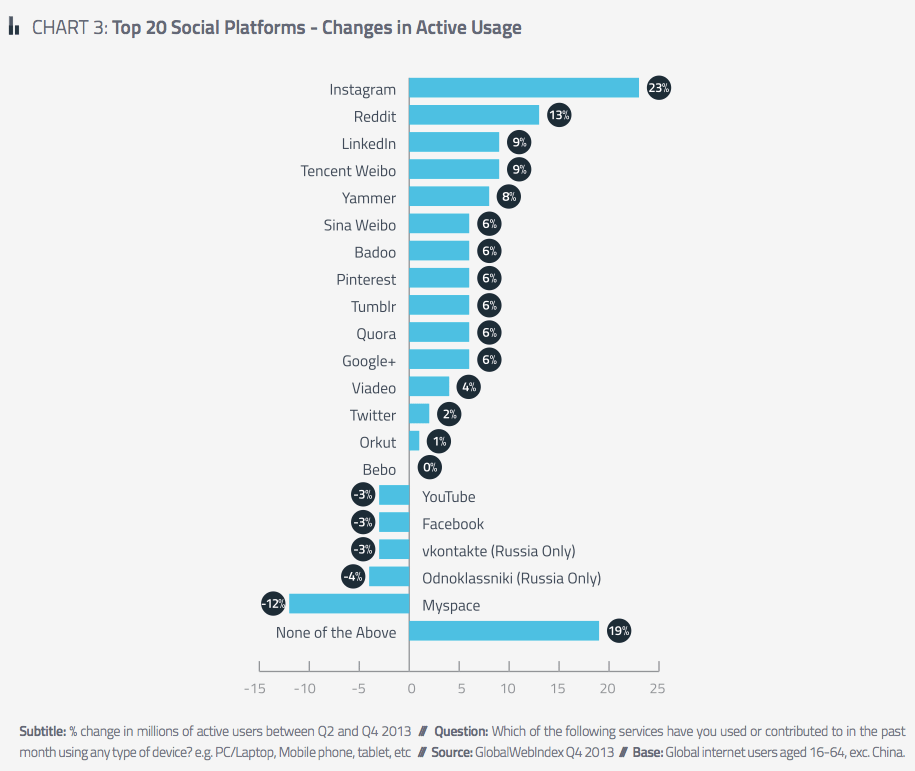
Should you decide which network to join based on its size?
Yes and no. Size matters inasmuch as you’d probably like the network you join to have reached a tipping point of users, popular enough that spending your time there will be time well spent. For that matter, even Pinterest’s 40 million users could be enough volume for you, especially if the demographics fit (see below).
At the same time, relying solely on size can be dangerous. First off, consistent social network data is hard to find. The active user stats above show a 215 million user gap between Twitter and Pinterest, yet other stories can claim Pinterest is more popular than Twitter (the difference in reporting comes down to surveys vs. stats, as well as the definition of popularity).
Also, size does not exist in a vacuum. There are scores of other factors that could be just as valuable or more valuable as you decide which networks to join. In some cases, size might be a false indicator of whether or not you should be on a particular network.
- Will more users mean more competition for attention?
- Are your customers on the network?
- Does the network fit your demographic?
- Does your industry have a presence?
Perhaps a better question is: Which social networks can users not live without?
The team at UTA Brand Studio has a tool to measure this social media dependence, and they shared findings earlier this year that showed exactly which social networks we’re most attached to.
The results, based on a survey of 2,006 U.S. adults, showed Facebook and Instagram in the top two spots.

These overall numbers are interesting on their own, and it gets even more so when you segment according to gender, age, and household income. Complete results are available in UTA’s SlideShare presentation.
For a taste of how things differ from gender and age, here are a couple of quick charts showing the rank of different networks.
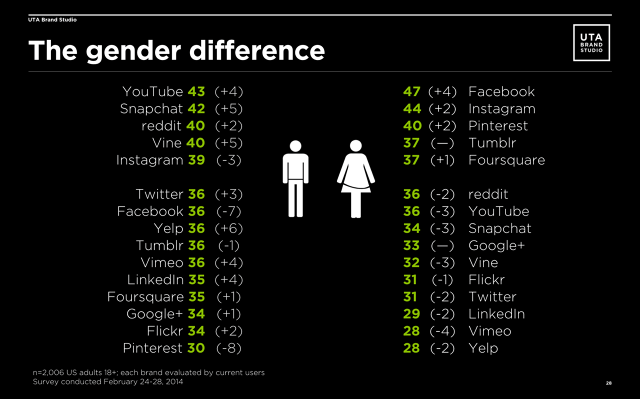

There’s lots more great demographic data to base your decision on, too.
Where are your customers? Here’s how to find out
What demographic data can tell you about choosing a social network
The Pew Research Internet Project has been compiling social media statistics and demographics for the past several years, releasing new information on a regular basis. Their latest demographic survey—a representative sample of 1,801 adults, surveyed in August and September 2013—shows who makes up the user bases for five major social networks.
Here’s a spreadsheet of the results. The numbers represent the percentage of online users who use each network. Google+ was not included in the survey.
(Note: Facebook is so far and away larger than the others that it’s kind of silly to compare them. I’ve highlighted the important numbers for everyone but Facebook. I could have highlighted the entire Facebook column.)
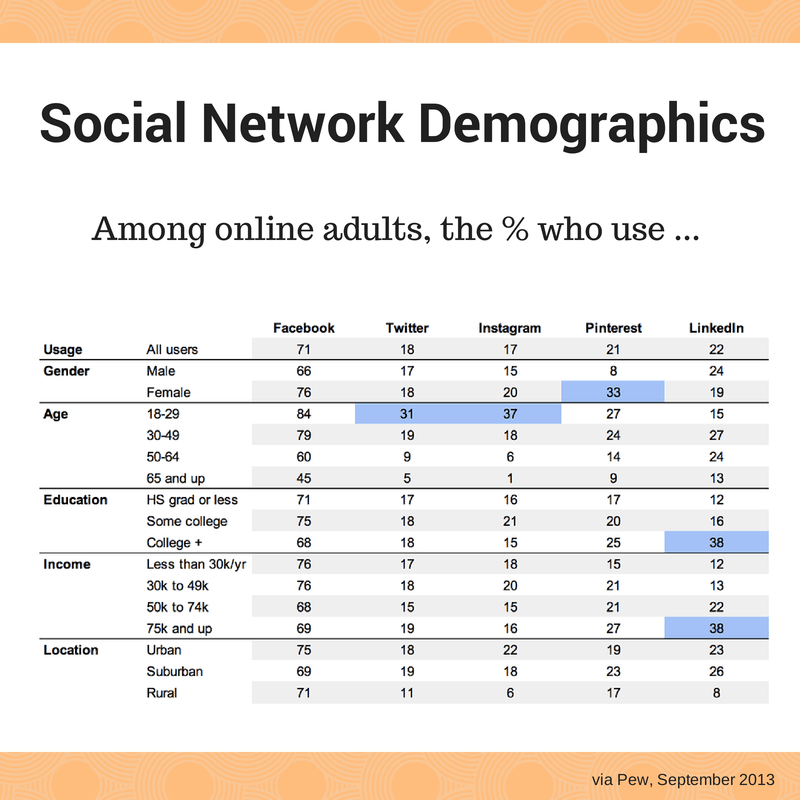
That’s probably a lot to digest. Here’s a quicker look at the social networks that provide the best fit in a number of different categories.

How might these stats impact your decision to choose the right social network?
It’s possible that you’ve created buyer personas for your customers, and you know general information about their age, gender, income level, and so forth. You can line up these insights with the demographic data of a social network and see which networks fit.
(For instance, I once worked at a company with an almost exclusively 65-and-over demographic. Instagram would not have been a major need for us.)
You can also judge the value of a social network based on how well it fits your content and strategy. If you create content that your audience loves, you’re likely to find your audience on social networks that love sharing your particular style of content—video, images, long-form, etc.
Here’s a helpful way of looking at it, courtesy of Jason DeMers at Search Engine Land. He broke down social networks into seven different types, each with their own characteristics.
- Kitchen-sink networks: Twitter and Facebook
- Image-based networks: Pinterest, Instagram, Tumblr
- Video networks: YouTube, Vimeo, Vine
- Business-focused networks: LinkedIn
- SEO and authorship networks: Google+
- Location-based networks: Foursquare, Yelp
- Niche networks: reddit

Important questions to ask when choosing a social network
Tim Grahl at Out:Think has a short and simple list of three of the big questions to ask when choosing a social network.
- Does it make sense for my content? (See the seven types of networks listed above.)
- Do potential fans spend time there? (See the demographic information above.)
- Does it make sense for me?
It’s this final piece—your gut—that could make the most telling argument for or against a social network. If you’ve done your research already and are still on the fence, answering the “gut” question might be the deciding factor.
Does it make sense for me? Is it something I can easily fit into my life? Do I have time to do it? After doing some research and observation, do I “get” how it works?
I find the last part of this question series to be particularly compelling. Many of us feel like we can learn a new network if given enough time. The only problem: When do we have enough time? If you’ve given it a go and it still doesn’t make sense, weigh this when deciding whether or not to press on.
Which social networks should you join? Here’re some answers.
Let me start off by saying that you can judge the necessity of your being on a social network by looking at the stats and asking yourself important questions. And then, if it’s still just too much to take in and you’d like someone to tell you what to do, here’re some answers.
Should you be on Facebook?
Yes, if you don’t mind the competition. More than 70 percent of online adults actively use Facebook. It is far and away the most popular social network. If your customers use the Internet, they’re very likely to be on Facebook. Consider, though, that with great popularity comes great competition. The News Feed is a crowded place for your business updates.
Should you be on Twitter?
Yes, if you’ve interested in a younger, tech-savvy crowd. Michelle Manafy of Inc calls many of the users “information junkies,” and it can be a wide variety of “information:” technology, news, sports, marketing, journalism, and so on. Topical and timely work great on Twitter. Be aware that a tweet reaches its peak after 18 minutes, so get your next tweet ready fast.
Should you be on LinkedIn?
Yes, if you can play the business game. LinkedIn’s audience is full of great insights on work productivity, networking, and job hunting. B2B companies love it. B2C companies are still figuring it out.
Should you be on Google+?
Yes, if you want to impact your SEO. There are other reasons to join Google+, of course. One of the biggest is that its user base is so large and the competition is so low. Each new post comes with SEO juice, too. A word of warning: Things might seem a bit quiet at times.
Should you be on Instagram?
Yes, if photography is your jam. Instagram works great in a pairing with Facebook or Twitter, and business is booming. More and more users join every day, albeit young ones.
Should you be on Pinterest?
Yes, if you have big visuals in your content. There’s a great demographic fit, too, for business that cater to women or brands that focus on categories like food or DIY.
Conclusion: How to choose a social network
It’s perfectly okay to pick and choose which social networks you join.
Small businesses may not be able to handle a consistent presence on four or more networks, so it’s helpful to step back, assess, and choose your best bets. Study the numbers, check for your audience, and ask yourself the important questions.
Which factors are most important to you when choosing a social network?
I’d love to hear about your experience in the comments. Do you try to cover as many social networks as possible? Have you chosen a select few to focus on? Come share your thoughts!
Image credits: UTA Brand Studio, TechCrunch,
Try Buffer for free
140,000+ small businesses like yours use Buffer to build their brand on social media every month
Get started nowRelated Articles

In this article, Nupur Mittal shares insights into four research methods that help her find content ideas and identify unique takeaways.

Facebook marketing in 2019 isn’t dead. On the contrary, it’s far from it. Now removed from the dim outlook that businesses faced at the beginning of 2018, Facebook has and will remain an essential tool for brands’ marketing strategies moving forward. In our big State of Social Media 2019 Report, we found that 93.7 percent of businesses use and are currently active on Facebook — the most among any other social media network. And although we continue to see a dramatic rise in the usage

